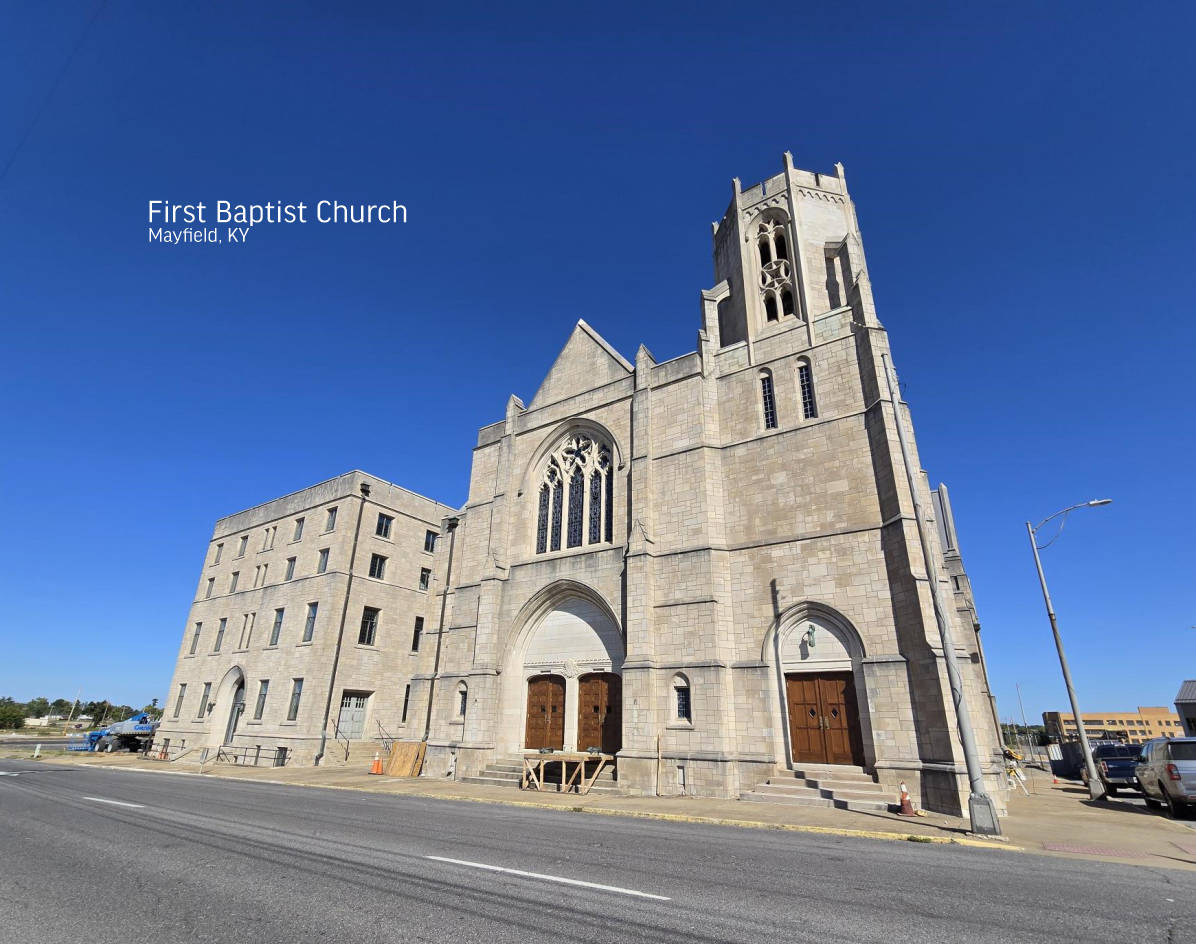In early 2024, we conducted a vital reconnaissance-level survey of the Downtown Mayfield Road Improvements Project area in Graves County, Kentucky. This survey, commissioned by the Kentucky Transportation Cabinet (KYTC), sought to assess the impact of federal regulations on historic-age architectural resources in compliance with the National Historic Preservation Act (NHPA). For Mayfield, a city that suffered significant loss during the devastating December 2021 tornado, the survey was not just a regulatory exercise—it was a reflection on what the city had lost and a guide for its future.
The Loss of History: A City Forever Changed
As BFW/Marcum’s team, led by historic preservationist Melinda Winchester, combed through the streets of Mayfield, they were struck by the gravity of the devastation that had reshaped the city’s architectural landscape. “I used to visit Mayfield regularly before the storm, and like many, I took so much of the architecture for granted,” Melinda reflected. “But when I started comparing the before and after photos during this survey, it really hit home just how much architectural fabric and history has been lost.”
Navigating Federal Preservation Rules
This survey was conducted as part of Section 106 compliance, a federal mandate that ensures any project utilizing federal funding or requiring federal permits must assess its potential impact on historic properties. Melinda, along with BFW/Marcum’s specialized team of engineers, environmentalists, and biologists, played a pivotal role in this process, helping Mayfield navigate the intricacies of federal preservation rules. “We work on the front end to help our clients be compliant with Section 106. It’s about making sure our clients are compliant and speeding up the process by addressing the requirements early on,” Melinda explained.
Balancing Modernization and Historic Preservation
Mayfield’s story is one of both tragedy and resilience. For project manager Mike McGregor, the delicate balance between preserving what remains of the city’s history and modernizing the infrastructure presents unique challenges. “The Mayfield Rebuild is unlike many other preservation projects because so many of the historic structures were destroyed in the tornado,” Mike said. “This means we don’t necessarily have to match the design criteria of what was there. However, the city passed an ordinance with design criteria for the downtown area, so we still need to honor Mayfield’s historic identity as we rebuild.”
Determining What to Preserve
For both Melinda and Mike, one of the most critical aspects of their work is determining which buildings and structures qualify as historically significant. As part of their survey, Melinda’s team evaluated over 285 parcels within a 2.5-mile corridor, identifying 14 that contained historic resources dating back as far as the 1890s. “We begin with a reconnaissance-level survey, identifying any potential NRHP-eligible buildings, structures, objects, or districts that might be impacted by the project,” Melinda said. “For the purposes of this survey, historic-age properties are defined as anything built before 1974.”
The process of deciding which buildings to preserve is both an art and a science, requiring deep collaboration between preservation specialists and engineers. “Our goal is to preserve the historic identity of Mayfield while improving the infrastructure,” Winchester said. “But at the end of the day, the city and its citizens will decide what their story is to tell future generations.”
Grants: A Lifeline for Small Towns
Mayfield’s path to recovery is further supported by federal grants such as Neighborhood Access and Equity (NAE) Program and Rebuilding American Infrastructure with Sustainability and Equity (RAISE), which provide critical funding to rebuild small communities after natural disasters. “These grants are absolutely essential,” said Mike. “Mayfield lost not only its architecture but also key infrastructure—streets, sidewalks, water lines, and emergency service buildings. Small towns simply don’t have the general funds to handle rebuilding their entire town without this kind of help.”
Grants like NAE and RAISE require only a small match from the community, allowing towns like Mayfield to leverage millions of federal dollars to rebuild more quickly and comprehensively. “With federal RAISE funds, Mayfield will be able to rebuild the downtown business district in a matter of years, a process that originally took decades,” Mike added. “The KYTC has been a tremendous partner in this process, providing the necessary support to secure these grants and even funding the match that Mayfield needs to proceed.”
Moving Forward While Honoring the Past
While much of the physical landscape of Mayfield may have changed, its historic spirit endures. The collaborative efforts of historic preservationists like Melinda and project managers like Mike ensure that as the small city moves forward, its large story remains woven into every new brick and beam. The rebuilding of downtown Mayfield is not just about restoration—it’s about creating a legacy that honors the past while embracing the future.


Recent Comments